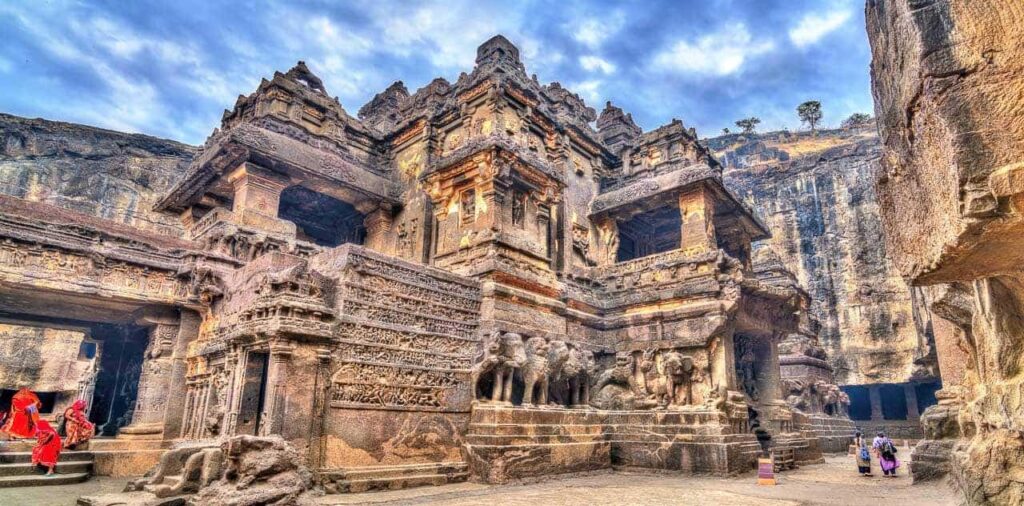Nestled in the Charanandri hills of Maharashtra, the Ellora Caves are an extraordinary representation of India’s rich cultural and religious heritage. Carved meticulously between the 6th and 10th centuries CE, these caves reflect a harmonious blend of Hinduism, Buddhism, and Jainism, making it one of the finest examples of ancient Indian rock-cut architecture. This UNESCO World Heritage Site is not only a marvel of engineering but also a symbol of India’s tolerance and diversity, where three major religions coexisted and flourished side by side.

Historical Background
The Ellora Caves were constructed over several centuries, with contributions from different dynasties, particularly the Rashtrakutas and the Yadavas. Unlike the Ajanta Caves, which primarily focus on Buddhist traditions, Ellora showcases the transition from Buddhism to Hinduism and finally, to Jainism. The caves are organized into three distinct groups based on religious affiliation—Buddhist (Caves 1–12), Hindu (Caves 13–29), and Jain (Caves 30–34).
Ellora’s strategic location on an ancient trade route made it an important hub of cultural and economic exchange. This significance is reflected in the grandeur and scale of the architecture, where the artisans and patrons aimed to create not just religious spaces but monumental works of art that would inspire awe and devotion for generations to come.
Architectural Brilliance: A Testament to Skill and Imagination
The Ellora Caves consist of 34 rock-cut temples and monasteries, each varying in size, style, and purpose. What sets Ellora apart is the sheer scale and ambition of its architecture, particularly the Hindu temples that showcase an intricate network of halls, courtyards, and shrines, all carved out of solid rock.
- Buddhist Caves (1–12): These are the earliest caves at Ellora, dating back to the 6th and 7th centuries. They primarily served as monasteries and are characterized by their simple yet elegant design. The highlight among these is Cave 10, known as the Vishvakarma Cave, or the “Carpenter’s Cave,” featuring a stunning chaitya hall with a vaulted ceiling, designed to mimic wooden beams. The large seated Buddha at the end of the hall, flanked by Bodhisattvas, is a striking example of early Buddhist sculpture.
- Hindu Caves (13–29): The most famous and architecturally impressive is Cave 16, also known as the Kailasa Temple. Dedicated to Lord Shiva, the Kailasa Temple is considered a masterpiece of Indian rock-cut architecture. It is the largest monolithic structure in the world, carved entirely from a single rock. The temple is a breathtaking spectacle of intricate carvings, sculptures, and towering pillars, portraying scenes from the Ramayana and Mahabharata. The scale and precision with which the temple was carved—descending from the top down—speak volumes about the ingenuity and skill of the artisans who worked on it.
- Jain Caves (30–34): These are the last caves constructed at Ellora, dating back to the 9th and 10th centuries. The Jain caves are smaller in scale but no less ornate, characterized by detailed carvings and an emphasis on symbolic motifs. Cave 32, known as the Indra Sabha, is the largest of the Jain caves and includes a beautiful lotus-carved ceiling and intricate sculptures of Tirthankaras. The Jain caves reflect the religion’s focus on asceticism and spirituality, with their serene and meditative atmosphere.
Symbolism and Significance
The Ellora Caves are a testament to the co-existence and mutual respect between different religious traditions in ancient India. The proximity of the caves to one another—Buddhist, Hindu, and Jain—illustrates a remarkable level of religious tolerance and artistic collaboration. The thematic representations in each cave tell stories of faith, mythology, and morality, inviting visitors to explore the rich tapestry of narratives and symbols that shaped ancient Indian thought.
The Kailasa Temple, in particular, symbolizes Mount Kailash, the mythical abode of Lord Shiva, and is designed to reflect the cosmic axis around which the universe revolves. The sculptures of gods, goddesses, and mythical creatures adorning the temple walls depict the struggle between good and evil, the cycles of creation and destruction, and the ultimate triumph of divine power.
Planning Your Visit
The Ellora Caves are located about 30 kilometers from Aurangabad, making them easily accessible by road. If you are planning a trip, consider the following:
- Best Time to Visit: The ideal time to explore Ellora is between November and March when the weather is pleasant and comfortable for sightseeing.
- How to Reach:
- By Air: The nearest airport is Aurangabad Airport (IXU), which has regular flights from major cities like Mumbai, Delhi, and Hyderabad.
- By Train: Aurangabad Railway Station is well-connected to cities across Maharashtra and beyond. From the station, you can hire a taxi or take a local bus to reach Ellora.
- By Road: Regular state-run buses and private taxis operate between Aurangabad and Ellora. If you’re coming from Mumbai or Pune, you can opt for a road trip, enjoying the scenic views along the way.
Tips for Visitors
- Start Early: Arrive early in the day to explore the caves at a relaxed pace, especially since the site covers a large area.
- Wear Comfortable Shoes: You’ll need to walk and climb stairs, so comfortable footwear is essential.
- Hire a Guide: The history and significance of each cave can be best understood with a knowledgeable guide.
- Respect the Heritage: Avoid touching or leaning against the carvings and sculptures to preserve these ancient treasures.
Conclusion
The Ellora Caves are a sublime manifestation of human creativity and devotion. As you walk through these timeless monuments, you are not just witnessing an architectural feat but engaging with a piece of history that transcends time and culture. This UNESCO World Heritage Site continues to inspire awe and admiration, reminding us of the enduring legacy of art, spirituality, and coexistence that shaped ancient India.

